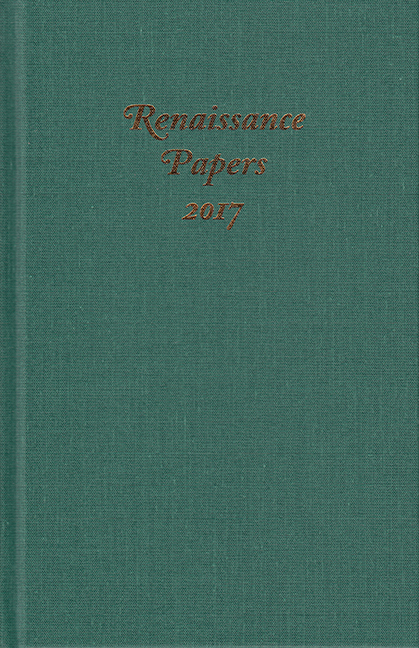Book contents
- Frontmatter
- Contents
- Dedication
- The Contested Pliability of Sacred Space in St. Paul's Cathedral and Paul's Churchyard in Early Modern London
- Classicism from Urbino: The Bichi Chapel Frescoes by Francesco di Giorgio Martini
- Visualizing the Paragone in Francisco de Zurbarán's Crucifixion with a Painter
- A Change in the Making: Shakespeare's Ovidian Sleep of Death and Display
- Old Black Rams and Mortal Engines: Transhumanist Discourse in Othello
- Dying with Speed and Felicity: Humor and Death in Book 3 of the Faerie Queene
- “If Devils Will Obey Thy Hest”: Devils in Dr. Faustus and The French Historie
- Rewriting Lucrece: Intertextuality and the Tale of Lucrece
- Economy and “Honesty” in Thomas Middleton's A Chaste Maid in Cheapside
- Glossing Authorship: Printed Marginalia in Aemilia Lanyer's Salve Deus Rex Judaeorum
- Botany and the Maternal Body in Titus Andronicus
- Unhorsing the Lustiest Challenger: Reflections on Chivalry in Richard II and Henry IV, Part 1
Classicism from Urbino: The Bichi Chapel Frescoes by Francesco di Giorgio Martini
Published online by Cambridge University Press: 04 April 2019
- Frontmatter
- Contents
- Dedication
- The Contested Pliability of Sacred Space in St. Paul's Cathedral and Paul's Churchyard in Early Modern London
- Classicism from Urbino: The Bichi Chapel Frescoes by Francesco di Giorgio Martini
- Visualizing the Paragone in Francisco de Zurbarán's Crucifixion with a Painter
- A Change in the Making: Shakespeare's Ovidian Sleep of Death and Display
- Old Black Rams and Mortal Engines: Transhumanist Discourse in Othello
- Dying with Speed and Felicity: Humor and Death in Book 3 of the Faerie Queene
- “If Devils Will Obey Thy Hest”: Devils in Dr. Faustus and The French Historie
- Rewriting Lucrece: Intertextuality and the Tale of Lucrece
- Economy and “Honesty” in Thomas Middleton's A Chaste Maid in Cheapside
- Glossing Authorship: Printed Marginalia in Aemilia Lanyer's Salve Deus Rex Judaeorum
- Botany and the Maternal Body in Titus Andronicus
- Unhorsing the Lustiest Challenger: Reflections on Chivalry in Richard II and Henry IV, Part 1
Summary
IN the Church of S. Agostino in Siena, founded in 1258, are the recently restored frescoes in the Bichi chapel attributed to Francesco di Giorgio Martini and his assistant Pietro degli Orioli. The works were painted in grisaille touched with gold and selected color touches in white and ultramarine, dating from 1490–94. The chapel was part of renovations in the late Quattrocento, and after a disastrous fire in 1747, was dramatically overbuilt by Luigi Vanvitelli in a completely classicizing idiom in 1755. The renovations in the eighteenth century included the characteristic neoclassical white plaster covering that obscured the late Quattrocento frescoes until 1977, when they were exposed and restored by the Kunsthistorisches Institut in Florence. Although these frescoes raise many important questions, this essay will focus on the Bichi chapel frescoes’ iconographic origins and the remarkable classicizing elements in these paintings that seem to have been derived from the patronage of the Humanistic court of Federigo da Montefeltro in Urbino.
In the Metropolitan Museum of Art, there is an example of Francesco di Giorgio Martini's painting style prior to his time in Urbino. In the small panel painting, he utilizes a traditional view of the Nativity (fig. 1), clearly influenced by the Revelationes of St. Birgitta of Sweden, as the composition is an Adoration of the Christ Child. Later examples of Nativity pieces, still utilizing the Brigettine iconographic allusion to the Adoration, in the Pinacoteca in Siena demonstrate the use of classicizing architectural elements and dramatic and emotive gestures that appear derived from Tuscan prototypes as well as the work of Piero della Francesca. The Nativity of Christ in the Bichi Chapel (fig. 2) utilizes a fragmented classical building that is used as the foundation for the rustic canopy covering the central Adoration with shepherds. Martini's architectural vocabulary, enriched by the humanistic classicism underwritten by Federigo da Montefeltro, was extended into his pictorial language in his later career on his return to Siena.
In the Birth of the Virgin fresco (fig. 3), Martini continued the use of classicizing imagery in the architectural setting of the bedchamber, its decoration including classical swags and the coffering of the barrel vaulted vestibule that mimics the entrance to a Roman domus.
- Type
- Chapter
- Information
- Renaissance Papers 2017 , pp. 17 - 30Publisher: Boydell & BrewerPrint publication year: 2018



